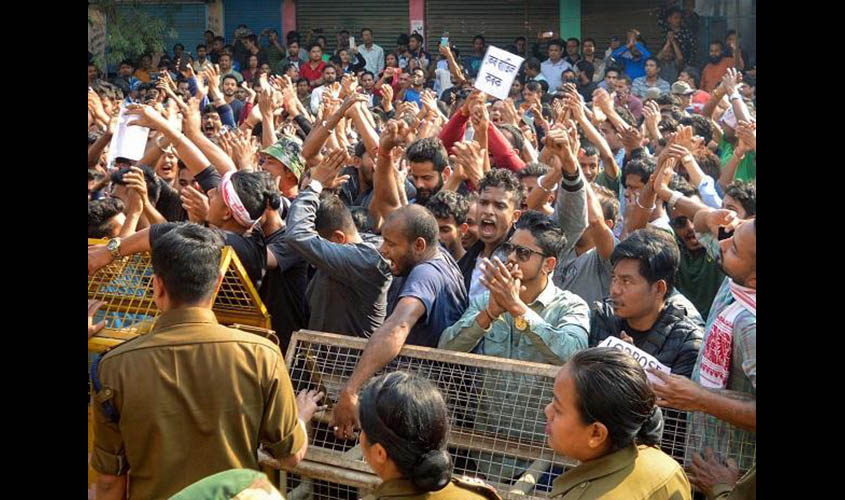The recent protests by students in various parts of the country over the implementation of the Citizenship Amendment Act (CAA) should not be taken lightly by the Centre. In fact, the government should reach out to the protestors, and try to comprehend their concerns while simultaneously making clear the official stand. The apprehension in the minds of these students has arisen due to ambiguity regarding the status of the National Register of Citizens, which the Home Minister had earlier announced would be implemented in the entire country.
The students perceive a concealed agenda behind the declaration of the CAA. The impression, also being fanned—by political parties and influential community leaders—was that the government was seeking to make India a Hindu Rashtra, and Muslims in particular, would have to prove their citizenship, in order to enjoy the privileges extended to all Indians. Therefore, the Prime Minister or the Home Minister must put to rest fears that now are being manifested through the agitation on the streets.
It is unlikely that the government would give in to the demand of retracting the CAA. The matter is bound to come up in the Apex Court which would take the final call. However, till then, in all probability there would be avoidable acrimony and preventable dissensions. The right to a peaceful protest is enshrined in our Constitution and students in most parts of the country, while expressing their solidarity with their fellow students in Jamia Millia Islamia, did so without violation of any law.
The Jamia violence acted as a catalyst for the nationwide stir, and should serve as a warning how mishandling of the situation by the police can lead to anti-government sentiments, which are definitely not in the interest of those in power. The eruption in Jamia was the result of poor planning and execution by the Delhi Police which despite being perhaps one of the finest forces in the country has of late, repeatedly been erring. Whether this is on account of weak leadership is a matter which the Home Ministry and the Lt. Governor should figure out, but the result is, that the ramifications of the Jamia violence are already being experienced in other regions. Mumbai, for instance, has never been in the forefront of political protests, but on Thursday, thousands of students marched out to demonstrate their misgivings regarding the CAA and both the brutal lathi charge and firing on the Jamia students.
What is presently happening is similar to the situation that unfolded when VP Singh, in order to save his government in August, 1990 announced the implementation of the Mandal Commission, without delving into its political fallout. Post-Mandalisation, there are several accounts given for the fall of his government. The most accepted version is about LK Advani’s decision to bring out his Somnath to Ayodhya Rath Yatra so as to reunite the Hindu society, that had been divided by the decision. The BJP, which supported the Central government, pulled out after Advani was arrested in Bihar, and seizing the opportunity, Chandra Shekhar replaced VP Singh.
However, what needs to be recalled with clarity is that matters would not have deteriorated so rapidly after the Mandal announcement, had the Delhi Police handled the protestors with its usual characteristic deftness and diplomacy. Students supporting and opposing Mandal had taken to the streets. On one particular day, the Delhi Police made a colossal mistake of allowing both the pro-Mandal and anti-Mandal protestors to converge at the Gole Methi Chowk, at that time a notified place for lodging protests. Unfortunately, for the police, the two segments arrived at the venue at the same hour and an inevitable clash ensued.
The police officials posted at the spot panicked, and began beating up the anti- Mandal agitators. Girls were struck by lathis and those attempting to escape by climbing up poles were mercilessly pulled down and thrashed. The district DCP and ACP were totally at sea on how to control the mayhem. The outcome was that violence spread like wildfire in other parts of the city. Soon after the Gole Methi incident, Rajiv Goswami, a student of Deshbandhu College, set himself aflame. Goswami, was later elected the DUSU president, but never recovered, succumbing a few years later to the burn injuries.
There were protests in the University Campus and also outside the INA market and the then intersection of the AIIMS and Safdarjung Hospital. The topography of the area has completely changed, so it would be difficult for readers to visualise how a large gathering of students sat there for days, blocking traffic. Finally the police, fired on the students resulting in the death of at least one. The Mandal implementation angered parents and citizens, resulting in the countdown of the VP Singh government. Advani solely took advantage of this strong anti-VP Singh and Mandal sentiment prevalent in the city to seize this opportunity.
Before this, Delhi had never witnessed such large scale protests. The closest was in 1972, when an agitation broke out against the then Vice Chancellor, Dr Sarup Singh, and nearly 25,000 students assembled at the Maurice Nagar Chowk. Violence erupted and five top student leaders including DUSU president Sri Ram Khanna, and NSUI nominee, Deepak Malhotra were rusticated.
The short point being that no government should mess around with students, who the world over, have as a consequence brought to an end the regimes of popular leaders. The only solution is to engage with them and allay their fears. Between us.

